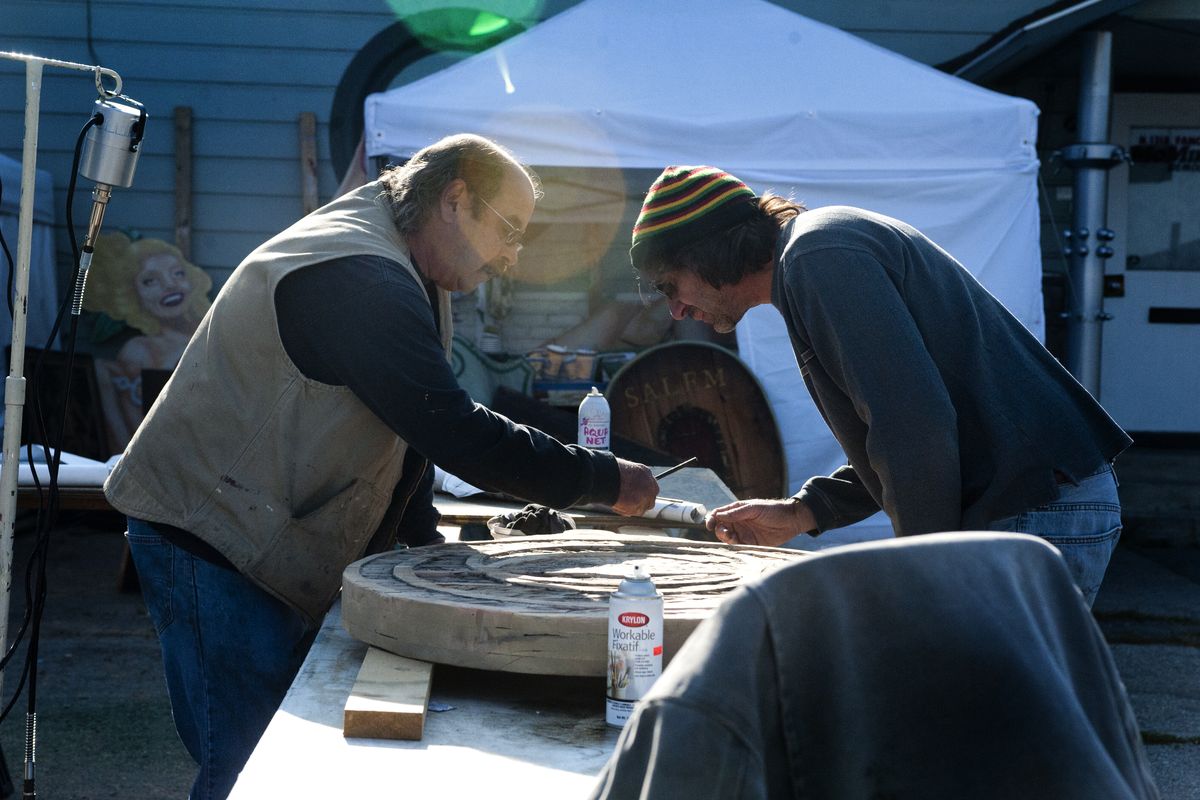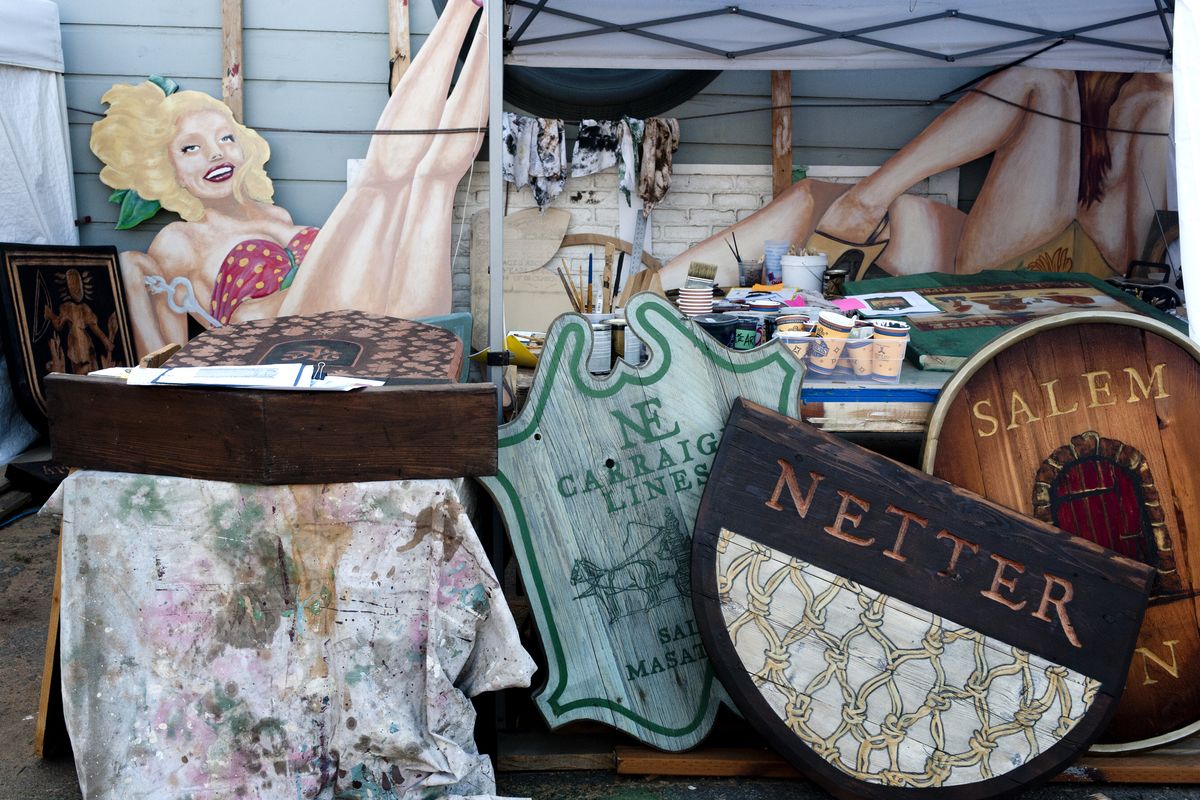Signs of success: Michael Ruby puts personal stamp on TV shows, movies
Michael Ruby, left, works with Mo Noder to craft a sign for a television miniseries about late-1600s Salem, Mass., for 20th Century Fox on Oct. 17 at MoMike Demolition in Spokane Valley. (Tyler Tjomsland)Buy a print of this photo
Twice in the 1993 film “Benny and Joon,” actor Johnny Depp visits American Classic Video, a shop distinguished by a prominent, hand-lettered logo in the window.
Each time the sign appears, Michael Ruby cringes.
“I told them it wasn’t finished,” explains Ruby, the sign’s creator, “but they were in a hurry and promised it wouldn’t show – it was just background. But in the film, it’s right there.”
Working for Hollywood takes a toll on perfectionists.
Yet since 1990, Ruby has contributed art to more than 50 films and TV shows, from “3:10 to Yuma” and “Deadwood” to “Get Him to the Greek” and “Anchorman.”
He recently carved 38 signs for a new 20th Century Fox Television series called “Salem.” The action is set in late-1600s Massachusetts and linked to the infamous witch trials, but with what its producers call a supernatural bent. The WGN network plans to run 13 one-hour episodes next year.
Ruby discussed his peripatetic career as he prepared to ship the bulky wooden “Salem” signs to Louisiana, where the pilot will be shot.
S-R: When did you become interested in art?
Ruby: In grade school in Billings. I was always doodling. Later, in high school, I took every art class I could. When someone needed something special drawn, they’d say, “Have Ruby do it.” My art teachers and my family encouraged me to pursue art.
S-R: Did you study art after high school?
Ruby: When I was 18, I got accepted to the Art Center College of Design in Pasadena (Calif.), but I couldn’t afford it. So after one year at Eastern Montana College (now Montana State University Billings), I dropped out and soon learned the meaning of the phrase “starving artist.”
S-R: How did you make ends meet?
Ruby: I repainted billboards that had pictorials on them. That was before large-format printers were used in the sign business. Billboards looked OK from the freeway back then, but when you got up close they looked like they’d been painted with a broom. When I repaint them, I tried to be a little cleaner.
S-R: Then what?
Ruby: Eventually an old sign painter took me under his wing and taught me lettering, painting, gold leaf, silk screening and more. I ended up working with him for years.
S-R: How did you get your start in films?
Ruby: I was repairing a hot tub in 1990 because the sign business was slow, and I met someone who was buying a bunch of fiberglass supplies. I asked what he was working on, and he said he was making glowing embers for a movie being shot in town. I told him I was a sign maker, he said I should come work on the movie – “Far and Away,” with Tom Cruise and Nicole Kidman. I learned a lot there from talented artists who had worked on things like “Bonanza.” They taught me how to make new signs look old.
S-R: What brought you to Spokane?
Ruby: I moved here to work for Orlyn Vigessa at Tri State Sign. When a movie job would come along, he was kind enough to let me take time off, sometimes months. After doing “Benny and Joon” and four more projects, including “Amazing Grace” with Patty Duke, I got into the Motion Picture Set Painters and Sign-Writers’ union and started doing movies full time – although “full time” is relative, because it’s a feast-or-famine business. From 1996 to 2008, I traveled all over the country, specializing in hand-painted signs.
S-R: When did you move back to Spokane?
Ruby: In 2009. But I still have an L.A. phone number, because I get so many calls from movie people I’ve worked with over the years.
S-R: What’s it take to succeed as a Hollywood sign painter?
Ruby: A lot of patience, and learning to deal with deadline stress. Like this “Salem” project – I had two months to carve, paint and ship 38 double-sided signs. Or the video-store logo in “Benny and Joon” – you think you have time to do something right, and then they need it a day early.
S-R: Do you create art or interpret others’ ideas?
Ruby: Both. On “Salem,” a graphic designer came up with the basic look for the signs, then let me go the extra mile to make them look old and more authentic.
S-R: How much does a sign painter earn working on a film?
Ruby: Typically about $50 an hour, but sometimes there’s double-, and even triple-time when they keep you on the set longer.
S-R: How has technology changed your job?
Ruby: I’ve had to get things like computer plotters and large-format printers. I have a 28-foot trailer filled with the equipment I need, and it’s delivered to wherever the movie is being made.
S-R: What’s the most recent film you worked on?
Ruby: “The Lone Ranger,” which was shot in Albuquerque. I did everything from signs for the towns and gold leafing for bank vaults to lettering a full-size locomotive and train cars.
S-R: Has technology limited your opportunities or increased them?
Ruby: It’s taken some away, but created others, because I can combine my hands-on artwork with computer-generated stuff.
S-R: Some people imagine working on a film must be glamorous. Is it?
Ruby: It’s far from glamorous. A lot is preproduction, but then they’ll change things while they’re shooting – especially on “The Lone Ranger” – and it’s last minute, quick-quick. If I’m hanging around the set, they always find something for me to do. And a lot of stuff I do doesn’t show up in the final cut.
S-R: What was your favorite film to work on?
Ruby: “Almost Famous” (a 2000 comedy-drama about a teenage journalist on assignment for Rolling Stone magazine). It was set in the 1970s – my period. I got to know (writer/director) Cameron Crowe, and he pretty much gave me free rein.
S-R: Have you appeared in any films?
Ruby: I was going to be in “Almost Famous” when they needed a shot with a sign painter, but then they got a taller guy. I’ve been in a lot of documentaries about the making of films I’ve worked on.
S-R: Who gets your props when filming is over?
Ruby: If it’s a really nice sign, it usually ends up in an actor’s or director’s house. It’s pretty rare that I get something back.
S-R: What advice would you offer someone who aspires to a career as a Hollywood artist?
Ruby: Think twice. It’s hard work.
S-R: What direction do you see your career going?
Ruby: I still want to do movie work, but I’d like to travel less and cater more to local businesses, using what I’ve learned in the movie industry to make signs that a typical shop wouldn’t do.
S-R: Any unusual requests so far?
Ruby: The owner of the Donut Parade (at 2152 N. Hamilton St.) wanted me to make a giant maple bar for his roof, but I didn’t think the roof could handle the weight.
S-R: Where can people see examples of your work?
Ruby: I have signs hanging on the main building at MoMike Demolition (1318 N. Fancher Road), where I have a studio.

